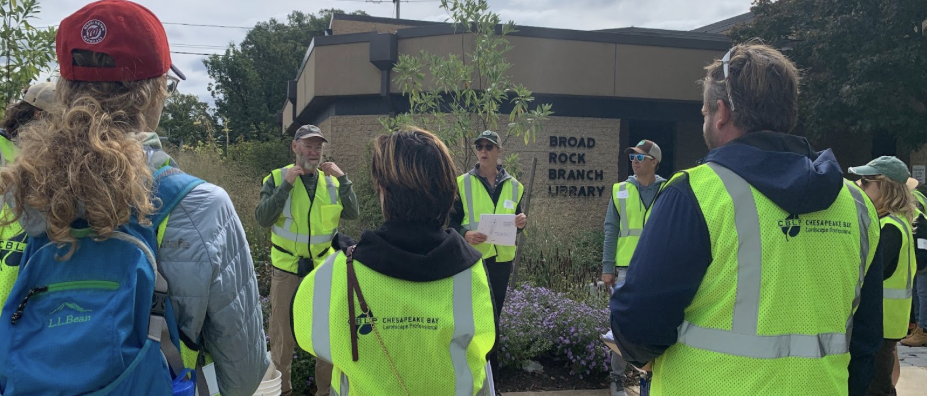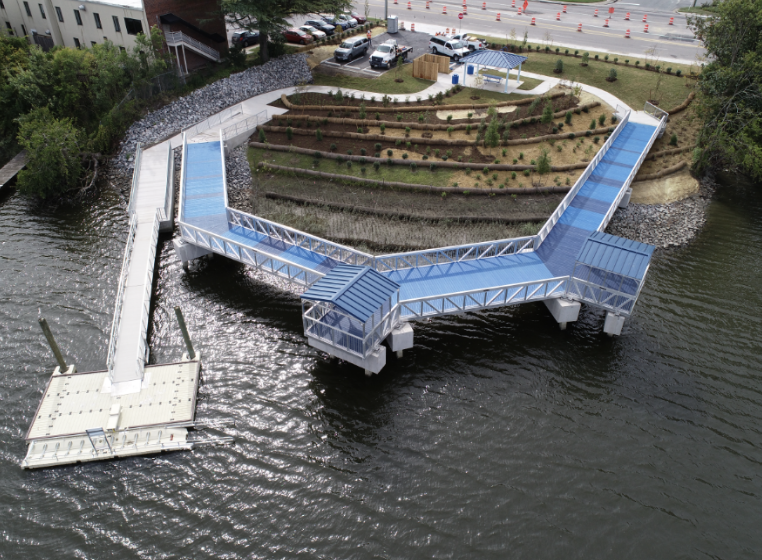Shereen Hughes: New Ambassadorial Role
As I prepare to slow down and move into an ambassador role for Wetlands Watch, I can’t help but be proud of how far we’ve come from concept to realization since I joined the organization in 2010. I am excited to see what is next for Wetlands Watch under the organizational leadership of Mary-Carson and Stacie McGraw and programmatic leadership of Jelani, Gabi, and Ian. We have a next generation of superstars growing professionally and working the Wetlands Watch way: fostering collaboration, embracing adaptive change, taking calculated risks, prioritizing solutions, and biased toward action.
The 2024 success stories that follow demonstrate the multifaceted Wetlands Watch approach of working collaboratively internally and externally, aligning our programmatic work with a wide variety of stakeholders and implementing solution-focused strategies that unify and connect. Our programs, our values, and our approach envision a resilient future in which all people and nature can co-exist, adapt, and flourish in a changing climate. I believe these success stories clearly demonstrate our mission focus: to enhance natural resilience, bolster community adaptation efforts, protect and restore wetlands throughout Virginia.
As always, we are grateful for all our partners working alongside us, charitable organizations who fund our work, and every individual that chooses to donate time and/or funding to Wetlands Watch.
As we celebrate these achievements, it's important to highlight the pivotal role that the Living Infrastructure Initiative has played in driving our mission forward. This initiative embodies our commitment to integrating nature-based solutions into every facet of our work, ensuring that our efforts not only protect wetlands but also enhance community resilience and environmental sustainability. By focusing on living infrastructure, we have been able to create meaningful and lasting impacts that benefit both people and nature, setting the stage for the continued success and pursuit of the Wetlands Watch mission.
You may have noticed how living infrastructure (including wetlands) and its multiple benefits to nature and people are a common thread weaving our mission and into all Wetlands Watch programmatic initiatives and adaptation strategies. Our training, resources, and engagement activities delivered through our Living Infrastructure Initiatives are designed to ensure the natural and nature-based resilience strategies are implemented successfully and strategically to provide attractive and functional options for communities and property owners to adapt and conserve nature and reduce risks to people in a changing climate.
We discovered early on that there simply weren’t enough people with the skills or interest in doing green infrastructure work. In 2014, to address this barrier, Wetlands Watch and our partners organized, funded, and developed the CBLP program, a training system and network of professionals to become better green infrastructure practitioners and environmental stewards. We’ve come a long way since piloting our Level 1 and 2 professional certification programs in 2016 adding new workforce and professional development certificates when interested partners approach us with support and funding. Through our (Wetlands Watch and CBLP) involvement with steering committees and action teams for the Upper and Middle James Riparian Consortium (Riparian Consortium) and the Living Shoreline Collaborative (LSC), we received funding and support to develop and pilot CBLP-Buffers and CBLP-Shorelines to increase availability of contractors in Virginia and beyond.
I am particularly proud of the CBLP program because I shepherded this program at Wetlands Watch from concept throughout my time here. This year we saw a lot of successes: in the expansion of our training programs and community of practice within Virginia and beyond; in the transition in leadership as I step down and Stacie McGraw and Gabi Kinney assume new leadership roles for Wetlands Watch and CBLP; and in recognition of two CBLP-designed resilient landscapes and shorelines at the Elizabeth River Project (ERP) Ryan Resilience Lab in Norfolk and the Blue Heron Landing Park in Chesapeake. Collectively, we have reached a point where this network of sustainable landscape and green infrastructure practitioners are being recognized and Wetlands Watch can see the impact achieved when we work to align our initiatives, programs, and messaging.
In 2023-24, as members of the Riparian Buffer consortium, we contributed to the development of the new DOF Virginia Riparian Forest Buffer Action Plan, worked with CBLP-Buffers training partners DOF and JRA and VEE funding to deliver CBLP-Buffers Beyond the Bay in Roanoke, and supported workforce development through the launch of a riparian buffer careers webpage.
In 2024, Wetlands Watch, Hirschman Water and the Environment, and the CBLP program worked with the Virginia Association of Soil and Water Conservation Districts (VASWCD) to develop and deliver a custom training for SWCD agents who manage the Virginia Conservation Assistance Program (VCAP), a green infrastructure cost-share program for private property.
This summer, we ran our 3rd CBLP-Shorelines workshop in Virginia and worked with CBLP to adapt and deliver the workshop in Maryland. The LSC also celebrated the grand opening of the first living shoreline project funded in part by the Virginia Agricultural Cost Share Program on the working farm of the Berkeley Plantation property. The Living Shoreline contractor and several project partners were members of the Wetlands Watch led LSC Training Team, earned the CBLP-Shorelines certificate through our pilot program, and informed development of our newly released Living Shoreline Resilience Design Guide: Designing Living Shorelines for Sea Level Rise in Virginia: A Resource for Practitioners funded by the Virginia Coastal Zone Management Program.
Our Native Biodiversity Program is also part of a collaborative, Community Based Social Marketing campaign developed through the Virginia Native Plants Marketing Partnership that we joined in 2011. Working with the Partnership, Wetlands Watch has supported regional native plant guides development and distribution helping to improve public appreciation for native plants, support native plant production and increase availability for green infrastructure projects. The guides are provided to and promote certified CBLPs and the Partnership has informed development of the CBLP Planting and Maintenance Guide for Stormwater Best Management Practices, and the recently released Riparian Consortium’s Riparian Buffer Plant Guide for Virginia. In 2024, Stacie McGraw, received a grant to support our continued leadership with the Partnership, to update the Native Plant Guide for Southeast Virginia and to reboot the native plants marketing campaign in Hampton Roads.
Photo credit: Rogard Ross, Friends of Indian River
Many know about the high profile Collaboratory projects at Ohio Creek in Norfolk, and most recently at Aberdeen Gardens in Hampton; however, just this month, we saw the grand opening of Blue Heron Run Park, a Collaboratory resilience design project from 2018. The park was designed by Kristina Bezanson, a CBLP Level 2 certified designer, Level 1 instructor, and Tidewater Community College Landscape Design Instructor for her final project needed to earn a Masters in Sustainable Landscape Design from George Washington University. We worked with Rogard Ross, also a certified CBLP, and the Friends of Indian River, ERP, and the City of Chesapeake’s Parks and Recreation Department to ensure that their goals and vision for this redevelopment project were met. As a technical advisor, I was able to guide revisions and modifications during the design process that resulted in a more resilient and adaptable design with the multiple benefits we promote through Wetlands Watch programs: manage shoreline erosion, reduce and manage stormwater runoff to improve water quality and mitigate flooding, restore natural floodplain functions in the flood zone, allow for wetlands migration, and increase biodiversity with native plants. These revisions allowed the park design partners to seek multiple funding sources to meet water quality goals, restore the Chesapeake Bay Resource Protection Area (CBPA) buffer, achieve better ratings through theNational Flood Insurance Program’s Community Rating System, and provide recreational amenities for the community. If you want more details, I encourage you to watch this video.
Another interesting twist to this story is the career, workforce, and professional development of other certified CBLPs that we can tie to Kristina Bezanson. At TCC, she instructed and mentored a number of certified CBLPs who we consider superstars in Hampton Roads. Trista Imrich, a Level 2 certified CBLP Designer, veteran, and small business owner, originally designed living shoreline projects for Lynnhaven River NOW, trained under Kristina, started her own native plant design business, Wild Works of Whimsy, recently acquired Southern Branch Nursery and employing whole new workforce of sustainably minded, CBLP certified staff. Her success is our success - her designs are creating a demand for sustainable landscaping with native plants that protect and buffer wetlands and her Nursery is meeting the growing demand for native plants. Stacie McGraw, another landscape design student at the time, remembers Kristina sharing her Collaboratory resilience design process with her class! It has been a pleasure to see Stacie grow and flourish while at Wetlands Watch and I personally am grateful for Kristina’s role in planting the seeds of resilience design by sharing her own learning journey with Stacie way back in 2018!
The Elizabeth River Project’s (ERP) new Ryan Resilience Lab with its resilient landscape and shoreline is an amazing example of so many Wetlands Watch-promoted resilience and adaptation strategies and program initiatives can be packed in one small urban redevelopment site. This is a story of what we can achieve when Wetlands Watch staff and our partners dare to be innovative, dedicate our time and resources towards realizing our long term goals, and have the patience and support of our funders and what communities can achieve by working together locally to align people, programs, planning, funding, and actions.
You may already know about Rolling Conservation Easement on the property, successfully negotiated, designed, and recorded because of Mary-Carson’s tenacity and tireless work with our partners at ERP, the Coastal Virginia Conservancy, Virginia Institute of Marine Science, Old Dominion University, and the City of Norfolk. What you might not know is the design, installation, management and monitoring of the resilient landscape and shorelines provided by certified CBLPs with Stromberg, Garrigan and Associates (SGA) and ERP. SGA incorporated sea level rise adaptation and adaptive management into their designs, ERP staff installed, monitor and adaptively manage the landscape and shoreline as sea level impacts are realized, and will also monitor flood levels to ensure compliance with the conditions of the Rolling Conservation Easement. This amazing model of resilient building methods and green infrastructure practices integrated into the entire site from the rooftop to the water’s edge will inform resilience and adaptation research, provide a learning laboratory and Co-hosting Wetlands Watch and CBLP professional development workshops and trainings, resilience tours for Collaboratory students and their professors and Catch the King training and celebration events.




